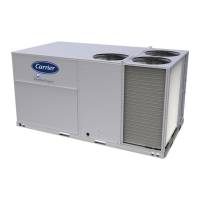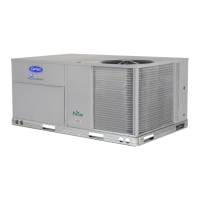28
When installing the gas supply line, observe local codes pertaining
to gas pipe installations. Refer to the NFPA 54/ANSI Z223.1
NFGC latest edition (in Canada, CAN/CSA B149.1). In the ab-
sence of local building codes, adhere to the following pertinent
recommendations:
1. Avoid low spots in long runs of pipe. Grade all pipe
1
/
4
-in. in
every 15 ft (7 mm in every 5 m) to prevent traps. Grade all
horizontal runs downward to risers. Use risers to connect to
heating section and to meter.
2. Protect all segments of piping system against physical and
thermal damage. Support all piping with appropriate straps,
hangers, etc. Use a minimum of one hanger every 6 ft
(1.8 m). For pipe sizes larger than
1
/
2
-in., follow recommen-
dations of national codes.
3. Apply joint compound (pipe dope) sparingly and only to
male threads of joint when making pipe connections. Use
only pipe dope that is resistant to action of liquefied petro-
leum gases as specified by local and/or national codes. If
using PTFE (Teflon
1
) tape, ensure the material is Double
Density type and is labeled for use on gas lines. Apply tape
per manufacturer’s instructions.
4. Pressure-test all gas piping in accordance with local and
national plumbing and gas codes before connecting piping to
unit.
NOTE: Pressure test the gas supply system after the gas supply
piping is connected to the gas valve. The supply piping must be
disconnected from the gas valve during the testing of the piping
systems when test pressure is in excess of 0.5 psig (3450 Pa). Pres-
sure test the gas supply piping system at pressures equal to or less
than 0.5 psig (3450 Pa). The unit heating section must be isolated
from the gas piping system by closing the external main manual
shutoff valve and slightly opening the ground-joint union.
Check for gas leaks at the field-installed and factory-installed
gas lines after all piping connections have been completed. Use
soap-and-water solution (or method specified by local codes
and/or regulations).
NOTE: If orifice hole appears damaged or it is suspected to have
been redrilled, check orifice hole with a numbered drill bit of cor-
rect size. Never redrill an orifice. A burr-free and squarely aligned
orifice hole is essential for proper flame characteristics. See
Fig. 33.
Fig. 33 — Orifice Hole
Step 11 — Install External Condensate Trap and
Line
The unit has one
3
/
4
-in. condensate drain connection on the end of
the condensate pan (see Fig. 34). See Fig. 4, 9, and 14 for the loca-
tion of the condensate drain connection.
The piping for the condensate drain and external trap can be com-
pleted after the unit is in place. Hand tighten fittings to the drain
pan fitting. Provide adequate support for the drain line. Failure to
do so can result in damage to the drain pan. See Fig. 35.
All units must have an external trap for condensate drainage. In-
stall a trap at least 4-in. (102 mm) deep and protect against
freeze-up. If drain line is installed downstream from the external
trap, pitch the line away from the unit at 1-in. per 10 ft (25 mm in
3 m) of run. Do not use a pipe size smaller than the unit connec-
tion (
3
/
4
-in.).
Fig. 34 — Condensate Drain Pan Connection
1. Teflon is a registered trademark of DuPont.
WARNING
Failure to follow this warning could result in personal injury,
death and/or property damage.
• Connect gas pipe to unit using a backup wrench to
avoid damaging gas controls.
• Never purge a gas line into a combustion chamber.
• Never test for gas leaks with an open flame. Use a
commercially available soap solution made specifically
for the detection of leaks to check all connections.
• Use proper length of pipe to avoid stress on gas control
manifold.
CONDENSATE
DRAIN
CONNECTION

